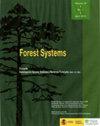Anthropogenic influences on deforestation of a peat swamp forest in Northern Borneo using remote sensing and GIS
IF 0.7
4区 农林科学
Q3 FORESTRY
引用次数: 0
Abstract
Aim of study: To study the anthropogenic factors that influence the fire occurrences in a peat swamp forest (PSF) in the northern part of Borneo Island. Area of study: Klias Peninsula, Sabah Borneo Island, Malaysia. Material and methods: Supervised classification using the maximum likelihood algorithm of multitemporal satellite imageries from the mid-80s to the early 20s was used to quantify the wetland vegetation change on Klias Peninsula. GIS-based buffering analysis was made to generate three buffer zones with distances of 1000 m, 2000 m, and 3000 m based on each of three anthropogenic factors (settlement, agriculture, and road) that influence the fire events. Main results: The results showed that PSF, barren land, and grassland have significantly changed between 1991 and 2013. PSF plummeted by about 70% during the 19-year period. Agriculture exhibited the most significant anthropogenic factor that contributes to the deforestation of the PSF in this study area with the distance of 1001-2000 m in 1998 fire event and 0-1000 m in 2003. Additionally, the distance to settlement played an increasingly important role in the fire affected areas, as shown by the increase of weightages from 0.26 to 0.35. Research highlights: Our results indicate that agriculture is the most influential anthropogenic factor associated with the fire-affected areas. The distance to settlement played an increasingly important role in the fire affected areas and contributes to the deforestation of the PSF in these study areas.利用遥感和地理信息系统研究人类活动对婆罗洲北部泥炭沼泽森林砍伐的影响
研究目的研究婆罗洲岛北部泥炭沼泽森林(PSF)中影响火灾发生的人为因素。研究区域马来西亚沙巴婆罗洲岛克里亚斯半岛。材料与方法使用最大似然算法对 80 年代中期至 20 世纪初的多时相卫星图像进行监督分类,以量化克里亚斯半岛的湿地植被变化。基于地理信息系统(GIS)的缓冲分析,根据影响火灾事件的三个人为因素(定居点、农业和道路),分别生成了距离为 1000 米、2000 米和 3000 米的三个缓冲区。主要结果:结果显示,1991 年至 2013 年期间,PSF、荒地和草地发生了显著变化。在这 19 年间,PSF 骤降了约 70%。农业是造成该研究区域 PSF 森林砍伐的最主要人为因素,1998 年火灾事件中的距离为 1001-2000 米,2003 年为 0-1000 米。此外,在受火灾影响的地区,与居民点的距离所占权重从 0.26 增加到 0.35,这表明与居民点的距离越来越重要。研究亮点:我们的研究结果表明,农业是对火灾影响最大的人为因素。在受火灾影响的地区,与居民点的距离扮演着越来越重要的角色,并导致了这些研究地区的 PSF 毁林。
本文章由计算机程序翻译,如有差异,请以英文原文为准。
求助全文
约1分钟内获得全文
求助全文
来源期刊

Forest Systems
FORESTRY-
CiteScore
1.40
自引率
14.30%
发文量
30
审稿时长
6-12 weeks
期刊介绍:
Forest Systems is an international peer-reviewed journal. The main aim of Forest Systems is to integrate multidisciplinary research with forest management in complex systems with different social and ecological background
 求助内容:
求助内容: 应助结果提醒方式:
应助结果提醒方式:


